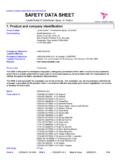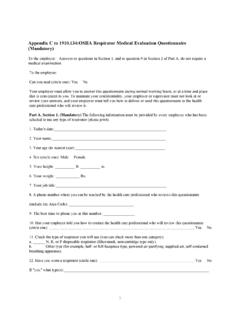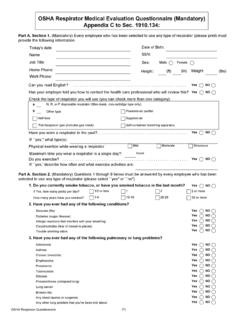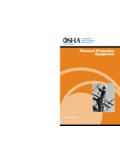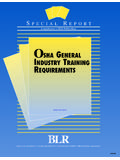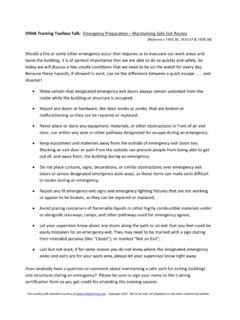Transcription of O S H A CHECKLIST FOR GENERAL INDUSTRY
1 O S H A CHECKLIST FOR GENERAL INDUSTRY Prepared by the South Carolina Department of Labor, Licensing and Regulation Office of osha Voluntary Programs INTRODUCTION The standards referenced in this CHECKLIST include South Carolina s Safety and Health Standards for GENERAL INDUSTRY as adopted from 29 CFR (Code of Federal Regulations) Part 1910 under the authority 1-15-210 South Carolina Code of Laws (1976) as amended. Pursuant to this authority, the Director of Labor, Licensing and Regulation has put into force and made public certain Occupational Safety and Health Standards which are identical to those enforced by the Secretary of Labor, United States Department of Labor. These standards are known as the Occupa- tional Safety and Health Rules and Regulations of the State of South Carolina and have been published as Article VI. The Office of osha Voluntary Programs conducts safety and health training programs and semi- nars at plant sites throughout South Carolina.
2 Training materials, such as this CHECKLIST , are used exten- sively in these programs . A list of programs, materials, and other training information is available upon request. In addition to these training programs, the Office of osha Voluntary Programs offers courtesy (consultation) services and technical assistance to employers in recognizing safety and health hazards and in developing and/or improving their overall safety and health programs. These services are free to private and public sector employers upon request, and no fine or citations are imposed. For more information or to set up an on-site consultation visit, call (803) 896-7744. This CHECKLIST has been compiled to help employers and employees comply with the Occupational Safety and Health Act of 1970. The questions in this list are based upon Article VI of the Rules and Regulations (Part 1910 of the Federal osha Standards) which contains standards for GENERAL INDUSTRY . This CHECKLIST , however, is only a guide to be used in conjunction with the osha Code of Federal Regulations Part 1910.
3 Compliance with it does not necessarily assure full compliance with all osha standards. This CHECKLIST is designed in such a manner that a negative answer to any question indicates an area of safety concern. If by using this CHECKLIST you should determine that a problem exists, or if a question or concern should develop, please contact: DEPARTMENT of LABOR, LICENSING and REGULATION OFFICE of osha VOLUNTARY PROGRAMS 110 Centerview Drive Columbia, South Carolina 29210 Phone: (803) 896-7744 Fax: (803) 896-7750 Email: Website: 3 osha CHECKLIST FOR GENERAL INDUSTRY SAFETY AND HEALTH SYSTEMS The South Carolina Department of Labor, Licensing and Regulation s Office of osha Volun- tary Programs has recognized that companies with effective Safety and Health Systems have reduced injuries and illnesses. This GENERAL INDUSTRY CHECKLIST will assist employers in Hazard Identification. However, Hazard Identification is only one element of an effective Safety and Health System.
4 There currently is no osha regulation requiring employers to establish a Safety and Health System, but the Department of Labor/ osha has published Safety and Health Program Management Guidelines (Jan. 26, 1989) for use by employers to prevent occupational injuries and illnesses. 1. Management Commitment and Planning (a) Do you have a written policy and goals? (b) Do you have a line of accountability? (c) Do you have resources available? (d) Does your company have management involvement? (e) Is coverage provided for contract workers? 2. Hazard Assessment (a) Do you conduct a pre-use analysis for new processes, materials, sub- stances, and equipment? (b) Does your company have a method of conducting a comprehensive survey? (c) Do you conduct periodic self-inspections? (d) Do you conduct a hazard analysis? (e) Is there a system in place for employee notification of hazards? (f) Is there a procedure for conducting accident/incident investigations?
5 (g) Is there a medical program in place? 3. Hazard Correction and Control (a) Do you have professional expertise available? (b) Are there procedures for hazard elimination and control? (c) Have you established a disciplinary system and is it used? YES/NO _____ _____ _____ _____ _____ _____ _____ _____ _____ _____ _____ _____ _____ _____ _____ 4 YES/NO (d) Do you have an emergency planning and preparedness program? (e) Do you have a preventive maintenance program? (f) Is there a system for tracking hazard correction at your facility? 4. Safety and Health Training (a) Do you have ongoing safety and health training? (b) Do you have training for new hires, both GENERAL and job specific? (c) Is there a method in place for tracking the training given? (d) Is training provided for management, supervisors, and employees? 5. Employee Participation (a) Are the employees involved in the safety and health program? (b) Do the employees participate in safety and health committees?
6 (c) Are safety observers, ad hoc safety and health problem solving, safety and health training, job hazard analysis, and contractor safety and health pr otection part of the employee participation? 6. Safety and Health Program Self-evaluation (a) Is an evaluation of the Safety and Health Management Program con- ducted at least annually? (b) Do you document the results and use them to improve upon your pro- gram? _____ _____ _____ _____ _____ _____ _____ _____ _____ _____ _____ _____ ADMINISTRATIVE REQUIREMENTS 1. osha Records (a) Are occupational injury and illness records current? Subarticle 3, Section , SCRR (b) Are exposure records maintained on employees that have been exposed to toxic substances or harmful physical agents such as asbestos, lead, radiation, (m)(1), (b) and (d), (n)(1) (c) Are required equipment inspection and modification records maintained such as maintenance and inspection records for power presses and cranes?
7 (j)(2-3) & (e)(1) _____ _____ _____ 5 2. First Aid Requirements (a) Are physician-approved first aid supplies on hand? (b) (b) Are these supplies replenished regularly? (b) (c) Is a certified first aid attendant available during all hours of establishment occupancy? (b) d) Are facilities available for quick drenching or flushing of eyes and body where corrosive materials are used? (c) YES/NO _____ _____ _____ _____ WALKING AND WORKING SURFACES 1. Are floors clean and dry? (a)(1) & (2) 2. Are permanent aisles and passageways appropriately marked and kept clear? (b) & (a) 3. Are load limit weights posted in the storage areas? (d)(1) 4. Is adequate lighting provided in work areas? (b)(6), (b)(6)(iii), (g), (h)(2), (a)(3)(i) & (c)(2) 5. Is every open-s ided floor, platform or runway four feet or more above adjacent floor or ground level guarded by a standard guardrail or the equivalent? (c) 6. Are all hatchway and floor openings guarded?
8 (a)(3) 7. Are floor holes into which persons can accidentally walk guarded? (a)(8) 8. Are covers or guardrails provided to prevent persons fr om falling into drainage ditches, open pits, vats, tanks, (c), (c)(3) & (g) 9. Are all fixed industrial stairways at least 22 inches wide? (d) _____ _____ _____ _____ _____ _____ _____ _____ _____ 6 10. Are all fixed industrial stairways provided with a stair railing on all open sides? (h) 11. Are closed stairways provided with a railing on at least one side? (d)(1) or (h) 12. Are all fixed stairways with a width in excess of 88 inches provided with a center stair railing? (d)(1)(v) 13. Is a seven foot vertical clearance maintained above any stair tread? (i) 14. Are scaffolds and their components capable of supporting without failure at least four times the maximum intended load? (a)(4) 15. Do all scaffold planks extend over end supports not less than six inches nor more than 18 inches?
9 (a)(13) 16. Are scaffolds properly braced so that the scaffold is always plumb, square, and rigid? (d)(3) 17. Are broken, bent, excessively rusted, altered, or otherwise structurally damaged scaffold frames or accessories removed from service? (d)(13) YES/NO _____ _____ _____ _____ _____ _____ _____ _____ EGRESS (OR EVACUATION) 1. Is an emergency action plan required for your company to meet a particular osha standard? (a)(1) (Note: Appendix ) 2. Where an emergency action plan is required, has an employee alarm system which complies with been established? (d) 3. Where an emergency action plan is required, has the employer reviewed the plan with each employee covered? (f) 4. Are exits markings and lighting adequate and appropriate? (b) _____ _____ _____ _____7 YES/NO 5. Are the number of exit routes adequate? (b) 6. Are means of egress continually maintained free of all obstructions or impediments?
10 (k)(2) 7. Are devices or alarms installed to restrict the improper use of an exit, designed and installed so that they cannot impede emergency use of such exit? (a)(3) 8. Do all exit routes meet the minimum height and width requirements at all times? (g) _____ _____ _____ _____ FIRE PROTECTION AND PREVENTION 1. Have procedures been established for sounding emergency alarms in the workplace? (b)(5) 2. Are portable fire extinguishers provided, mounted, located and identified so that they are readily accessible to employees? (c)(1) 3. Are fire extinguishers selected and distributed based on the classes of anticipated fires and the size and degree of hazard? (d)(1) 4. Where portable fire extinguishers are provided for employee use, is there an educational training program to familiarize employees with principles of use and hazards involved with incipient stage firefighting? (g)(1) 5. Are portable fire extinguishers hydrostatically tested as required?
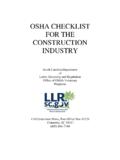
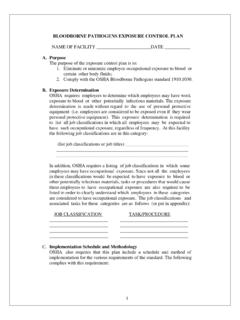

![Material Safety Data Sheet [OSHA 29 CFR 1910.1200]](/cache/preview/4/c/b/c/4/a/8/a/thumb-4cbc4a8a9c5d11b0cd83f70485b4b281.jpg)
